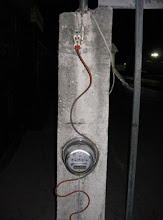It took me a while to figure out how to access the generic port map of a VHDL entity within the schematic view, so now that Ive managed it, heres a new post about it!
The schematic editor included in Xilinx's ISE isnt very user friendly, though the concept of using a schematic to "program" your FPGA or CPLD is not a bad one... especially using a schematic for the top-level structural design allows you to have a good overview of the overall program structure. But, schematics are yuppy, and yuppies must pay for their fancy user-friendly graphical tools, no? So, lets do what we can with what we've got...
Thursday, October 7, 2010
Wednesday, May 19, 2010
Beginners OMAP-L138 ARM Tutorial
Dear All Y'all
todays exercise: writing your very first program for the new, dual-core (one ARM9 core and one C6000 series DSP core), TI applications processor, the OMAP-L138. This simple tutorial is for the ARM core, and here are the boundary conditions:
todays exercise: writing your very first program for the new, dual-core (one ARM9 core and one C6000 series DSP core), TI applications processor, the OMAP-L138. This simple tutorial is for the ARM core, and here are the boundary conditions:
- Windows 7, 64-bit
- Code Composer Studio 4.1.1 (with the free limited license)
- Low-cost XDS100v2 USB Emulator
Labels:
ARM9,
Code Composer Studio,
OMAP-L138,
OMAPL138,
Texas Instruments,
Tutorial
Tuesday, April 13, 2010
Order component designators sequentially in Altium Designer
Heres one thing that I often have to do and always forget how it went.
Its annoying, but we're gonna have to deal: when you place components in Altium, the component designator is NOT automatically set to be the next one in sequential order. Ie, you just finished placing a few 0805 package resistors, the final one with the designator R105, and you switch to a MELF resistor. As long as the parts you are placing have the same component name (and perhaps the same logical symbol), the numbering of the designators will take up where you left off, with R106. If you start using a component with a NEW name, suddenly Altium doesnt suggest designator R106, but rather 'R?'. Yep.. annoying.
Good news, this can be easily fixed:
Its annoying, but we're gonna have to deal: when you place components in Altium, the component designator is NOT automatically set to be the next one in sequential order. Ie, you just finished placing a few 0805 package resistors, the final one with the designator R105, and you switch to a MELF resistor. As long as the parts you are placing have the same component name (and perhaps the same logical symbol), the numbering of the designators will take up where you left off, with R106. If you start using a component with a NEW name, suddenly Altium doesnt suggest designator R106, but rather 'R?'. Yep.. annoying.
Good news, this can be easily fixed:
- Tools >> Annotate Schematics
- Click Reset All to reset all designators to R?
- Click Update Changes List to generate new proposed designators
- Click Accept Changes --> Execute Changes
Tuesday, February 23, 2010
Josh Sully (Avatar) is the American Taliban
Dear all y'all -
I'm behind the times: I just got back from my first viewing of Avatar. One syllable: rock.
Firstly, it must be said that this film doth penetrate (er... penetrateth?) deep the heart of Chicken Freighter with its main theme of nature versus machinery. But, lets face it, I don't want to take the time to write about that, and you, Websurfer0xF2A910EE, obviously aren't going to have more than 47 seconds to read a blog entry.
So on to my Hauptanlegen: Josh Sully is clearly a representation of the American Taliban, John Walker Lindh. Heres why...
I'm behind the times: I just got back from my first viewing of Avatar. One syllable: rock.
Firstly, it must be said that this film doth penetrate (er... penetrateth?) deep the heart of Chicken Freighter with its main theme of nature versus machinery. But, lets face it, I don't want to take the time to write about that, and you, Websurfer0xF2A910EE, obviously aren't going to have more than 47 seconds to read a blog entry.
So on to my Hauptanlegen: Josh Sully is clearly a representation of the American Taliban, John Walker Lindh. Heres why...
Tuesday, February 9, 2010
Altium Designer Polygon Pours - Turning off Thermals
I started doing PCBs using Cadsoft's EAGLE program, which I think is a great mix of user-friendly and powerful (though I must admit, when I first started with EAGLE I remember wondering why it is not intuitively structured). Migrating to Altium, I'm inclined to think in EAGLE.
When you want to fill a section of your PCB with copper (i.e. to reduce the inductance on a signal, for increased thermal conduction, or to reduce the amount of copper you are going to have to etch away in an acid bath), you can use the command poly, or to select the polygon tool.
In EAGLE, you can activate or deactivate 'thermals' on your polygons. To adjust thermal relief settings in Altium Designer, you just have to change a few settings. Details after the jump!
When you want to fill a section of your PCB with copper (i.e. to reduce the inductance on a signal, for increased thermal conduction, or to reduce the amount of copper you are going to have to etch away in an acid bath), you can use the command poly, or to select the polygon tool.
EAGLE Polygon tool
Subscribe to:
Comments (Atom)

